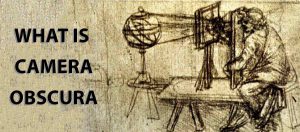Many works of art, such as paintings, drawings, etchings, and silkscreens, exist in two dimensions. Despite the limits of a flat surface, the artist can assign three-dimensional qualities to the elements of a work of art. Using various techniques, the artist can create a scene with towering mountain peaks that look to be many miles away – all on a two-dimensional canvas that is only a few feet or inches away.
What is perspective?
To comprehend perspective, envision a painting or drawing as a trace of a scene as seen through a window. As a result, the objects seen via the window are perfectly scaled down. A tree visible through the windows may be 40 feet tall in reality, yet it may barely take up an inch of paper on the tracing if it is far enough away.
If the artist could bring the window closer together, the object would appear larger and thus be drawn larger on the page. The object would diminish in size relative to the artist if the artist pushed the window further away. Artist can convey depth and distance by varying the sizes of the objects in relation to one another.
Perspectives of various kinds
The amount of “vanishing points” in a perspective drawing determines its classification. A vanishing point is a single point in art when two parallel objects appear to converge into one. A straight train track, for example, will ultimately obscure into a single line at the viewer’s peripheral vision.
One Point Perspective
A painting or drawing with a single vanishing point along a horizontal line, either vertically or horizontally, is said to have one point perspective. This most typically comprises images of corridors, buildings, highways, railways, or other parallel-lined items.
One Point Perspective
When two or more vanishing points exist on a horizontal line, a two point persecutive occurs. This might be a street corner with one road terminating diagonally in one direction and the other road terminating diagonally in the opposite direction, or a river forking off in two separate directions.
Three Point Perspective
When two or more vanishing points exist on a horizontal line, a two point persecutive occurs. This might be a street corner with one road terminating diagonally in one direction and the other road terminating diagonally in the opposite direction, or a river forking off in two separate directions.
Four-point or infinite-point perspective
An infinite-point viewpoint has more than three vanishing points on the horizon line. This normally results in a curved or spherical image, but it can also produce a “impossible” scene when the scope of the scene shown exceeds 360 degrees.
Zero Point perspective
It is also conceivable to have a picture or drawing with no parallel lines and, as a result, no vanishing points. This perspective would be found in a sloping valley, motionless pond, or any natural picture where parallel lines are uncommon and appear artificial. Despite the lack of Vanishing points, the artist can still communicate depth and distance.
Perspective's History
Ancient artists rarely used perspective and instead based the size of the figures depicted on importance rather than distance from the spectator. It is apparent that mediaeval and possibly early Greek artists knew the concept of perspective but ignored it when it suited their interests. A painter, for example, might portray a human figure that is only slightly smaller than the building he is standing next to, with small figurines that are only slightly smaller than the building he is standing next to, and with small figures standing atop the same building. The structure is shown as both small and huge.
Our modern geometrical understanding of perspective did not emerge until the Italian Renaissance. Filippo Brunelleschi, an architect, realised in the early 1400s that he could design a scene in such a way that it appeared identical to the viewer’s experience of viewing the same sight from a specific place. To demonstrate this, he painted the Florence Baptistery and made a hole in it so that the observer could gaze through the back and see themselves in a mirror. To the viewer’s surprise, the reflection in the mirror looked exactly like the actual Baptistery when viewed from the same vantage point. The Renaissance creative community immediately accepted Brunelleschi’s method.
So near, yet so far away
Although many ancient and mediaeval artists did not use perspective in the same way that we do now, they did use similar techniques—just in reverse. Rather than depicting distant items as smaller with parallel lines converging at a distant vanishing point, they frequently painted distant objects as larger than closer objects with parallel lines converging at a vanishing point off the canvas, typically where the observer would be standing. This was especially frequent in early Christian painting, where prominent subjects such as the Virgin Mary and Jesus were shown as gigantic figures even when they were in the background with smaller characters in the foreground.


